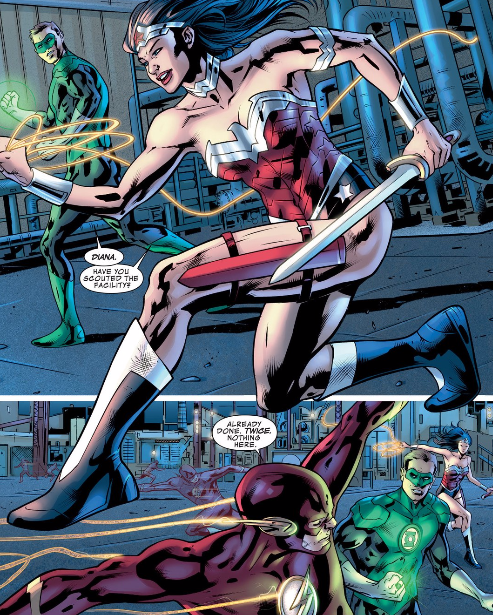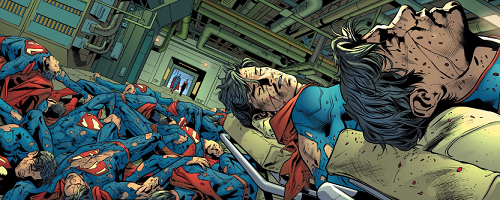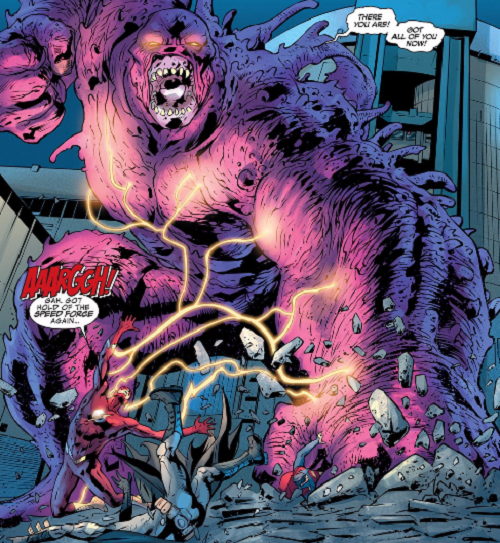
Justice League of America #1
By Bryan Hitch
Inks by Daniel Henriques with Wade Von Grawbadger and Andrew Currie
Colors by Alex Sinclair with Jeromy Cox
Letters by Chris Eliopoulos
DC Comics
“You might find what you see disturbing. Please. Try to keep an open mind.”
You’ve probably seen or heard the word “widescreen” associated with writer/artist Bryan Hitch; DC even used it for the marketing campaign for this series launch. Hitch is best known for his work drawing “cinematic” comics epics like The Ultimates and The Authority. You bring in Hitch when you want to go big or go home, and, thankfully, Hitch has delivered with the premiere of the new Justice League of America, which aims to rival the scope of Grant Morrison’s essential nineties JLA run.
Like in Morrison’s JLA, here the Big Seven (Batman, Superman, Wonder Woman, The Flash, Green Lantern, Aquaman, and Martian Manhunter Cyborg) feel like larger-than-life, godlike figures about to embark on an adventure of cosmic proportions. Already there’s some time travel, a cryptic conspiracy, and the arrival of a malevolent force from outer space that threatens all of reality. This is the kind of story the Justice League is for, and resonates a level of foreboding that’s been largely absent from Geoff John’s core Justice League book. The debut of this Justice League of America feels more akin to Mark Waid’s brief run on JLA in the early 2000s, which isn’t surprising given that Hitch was the primary artist during that run. This is is unquestionably the same storyteller who gave us Heaven’s Ladder and “Tower of Babel.”
To give you just a taste of the story, this issue turns on the surreal image of Superman walking into a room and finding his own dead body—sixty of them. They’ve each arrived from a near future in which they failed to save the universe from some unknown threat. Over and over, Superman’s lifeless body appears at the mysterious Infinity Corporation, until one finally comes back alive—alive just long enough to deliver a few cryptic words of warning.
I had a few concerns going into this issue, the first being the price. JLA #1 is a whopping $5.99— twice the price of your average DC book—but at 48 pages, it’s also twice as thick. Knowing Hitch’s reputation for sprawling two-page spreads, I’d feared that I’d get less than a normal issue’s amount of story in twice as many pages, and end up feeling as if I’d wasted my money. That turned out not to be the case at all; while JLA #1 certainly has its share of big action panels, the issue actually took me quite some time to read, and accomplishes a great deal. It ended up feeling like money well spent.

Our heroes are often seen bursting out of panels, a great way to make the characters seem larger than life.
My second concern was that Hitch would be also be writing the book, something he hasn’t been doing for very long. Forgive me for this prejudice, but experience has taught me to beware of DC books written by well-known superhero comics artists. For instance, Tony Daniel and David Finch both served as writer/artists on Batman titles back at the New 52 relaunch, and both were Liefeldian disasters. But in his JLA writing debut, Hitch seems equally interested in words and pictures, in fact the issue is surprisingly talky. A career spent crafting narrative brain teasers with Warren Ellis and Grant Morrison has clearly informed his voice as a writer.
It’s not all flowers and sunshine; while there are big ideas and some pretty panels of punching, the biggest weakness of this issue so far is characterization. This is, arguably, the hardest part of writing a Justice League story: balancing an ensemble cast of characters who each have their own solo books in which to develop. Most of the League doesn’t get much time to shine in this issue, and the result is that they each feel very flat. Were this my first DC comic (and as this is called Justice League of America #1, safe bet is it’ll be somebody’s first), I would walk away knowing nothing about The Flash, Green Lantern, or Cyborg as characters.
This issue focuses mainly on Superman, and based on the reveal on the last page, likely will continue to do so, but Superman himself feels a mite stiff and grouchy for my tastes. It could be my relative inexperience with the more brash, edgy version of the character seen in the New 52 thus far, but the words “gruff” and “impatient” come to mind, and that’s something I’m not used to coming from the Man of Steel. In a team that’s already stacked with rankled badasses (Batman, Aquaman, sometimes Wonder Woman), it’s that much more important to have a beacon of positivity to level things out, and this version of Superman doesn’t appear to play that role.
On the whole, Justice League of America is off to a promising start, and could be the stand-alone flagship DC team book that the core Justice League book isn’t. Taking place before Convergence means that this JLA not only features the more iconic versions of each character, but that it should also be safe from derailment by line-wide crossover events. It likely won’t have any real impact on continuity, but that’s a small price to pay for what we can expect to be a short, creator-driven run with a beginning, middle, and end.
Justice League of America #1 is available now online and at your local comics shop.



